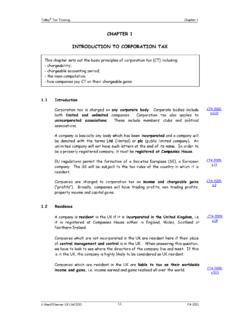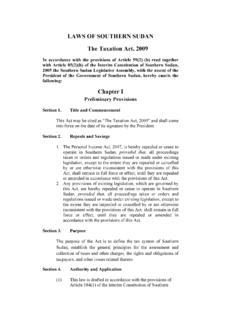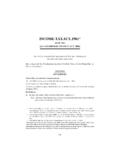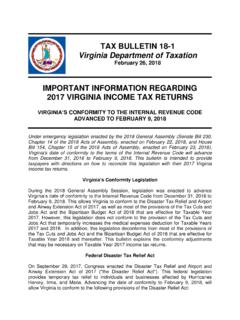Transcription of SECTION 530: ITS HISTORY AND APPLICATION IN LIGHT OF …
1 SECTION 530: ITS HISTORY AND APPLICATION IN LIGHT OF THE FEDERAL DEFINITION OF THE EMPLOYER-EMPLOYEE RELATIONSHIP FOR FEDERAL TAX PURPOSES National Association of Tax Reporting and Professional Management February 28, 2009 Principal Author: William Hays Weissman Littler Mendelson, Treat Towers 1255 Treat Blvd., Suite 600 Walnut Creek, CA 94597 Authorized for release by NATRPM Board on March 2, 2009: Jerri LS Langer, Member of NATRPM Board and GRC Coordinator I. INTRODUCTION A. Purpose of Paper. The purpose of this paper is to provide pertinent decision makers a concise HISTORY of SECTION 530 of the Revenue Act of 1978 ( SECTION 530) and the development of employer-employee relationship as defined for federal tax purposes to allow for a better understanding of current and proposed policies with respect to worker classification issues.
2 It also raises concerns about current administration of SECTION 530 and proposes possible solutions. B. National Association of Tax Reporting and Professional Management. The National Association of Tax Reporting and Professional Management (NATRPM) is a non-profit corporation organized to address the tax reporting and payroll industries international, federal, state and local legislative and regulatory issues, technical tax issues, technology developments, and operational issues. Its members include accountants, attorneys and others that provide employers advice and counsel regarding compliance with federal, state and local payroll and tax reporting issues. C. Organization of this Paper. In addition to this Introduction, SECTION II explains the HISTORY of the development of the usual common law rules used to determine whether a worker is an employee or independent contractor and provides a short primer on the meaning of the phrase.
3 SECTION III provides the HISTORY of SECTION 530, its purpose and how it operates. SECTION IV describes the IRS administration of worker classification cases in LIGHT of SECTION 530, with particular emphasis on changes since 1996. SECTION V discusses current legislative proposals to change SECTION 530. SECTION VI sets forth concerns about how SECTION 530 is being applied by the IRS. SECTION VII proposes some suggestions for improving SECTION 530 compliance. 1 II. HISTORY OF THE EMPLOYER-EMPLOYEE RELATIONSHIP FOR FEDERAL TAX PURPOSES One of the most confusing and difficult concepts to understand in federal tax law is the dividing line between employees and independent contractors.
4 Nonetheless this distinction is critical for numerous reasons, including, but not limited to, whether a person paying a worker is liable for withholding and remitting federal Income, Social Security, and Medicare taxes from the worker s pay, how certain fringe benefits should be taxed, and the right to deduct certain kinds of expenses. With certain exceptions, the determination of the employer-employee relationship is based on the usual common law rules. 1 This seemingly innocent sounding definition, however, has a long HISTORY that is pertinent to issues today. A. HISTORY of common law rules for worker classification for federal tax purposes. As originally enacted, the Social Security Act did not contain an express definition of an employee. Shortly after enactment of the Social Security Act the United States Treasury Department enacted regulations that adopted the common law control test to determine whether a worker was an employee or an independent contractor for federal employment tax Despite the Treasury Regulation, the federal courts used conflicting tests to determine a worker s status for employment tax purposes.
5 These conflicting tests culminated in 1947 in two United States Supreme Court opinions: United States v. Silk 3 and Bartels v. In Silk and Bartels the Supreme Court held that while control was an important factor to consider, it was not the only one. Rather, the worker s status should be considered in LIGHT of the purpose of the social security legislation and employees included those who as a matter of economic reality were dependent upon the business to which they rendered services. 5 As a result of Silk and Bartels, the United States Treasury Department promulgated new regulations in 1947 defining the employer-employee relationship on the basis of the economic reality test. The proposed regulation caused considerable criticism in Congress and lead to enactment in June 1948 of 296 (62 Stat.)
6 438) 1 , IRC, 3121(d)(2) ( (d) For purposes of this chapter, the term employee means - .. (2) any individual who, under the usual common law rules applicable in determining the employer-employee relationship, has the status of an employee .. ). 2 See 1 1764 (1936) (reproduced and discussed in United States v. Silk, 331 704, 714 n. 8 (1947)); see also Illinois Tri-Seal Products, Inc. v. United States, 353 216, 224 (1965). 3 United States v. Silk, 331 704 (1947). 4 Bartels v. Birmingham, 332 126 (1947). 5 Illinois Tri-Seal Products, 353 at 225 (discussing HISTORY of the conflicting tests used by federal courts that culminated in the Silk and Bartels opinions). 2 over President Truman s veto.
7 6 The Gearhart Resolution was intended to maintain the status quo in respect of certain employment taxes by including a definition of employee in the Internal Revenue Code as follows: employee does not include (1) any individual who, under the usual common-law rules applicable in determining the employer-employee relationship, has the status of an independent contractor or (2) any individual (except an officer of a corporation) who is not an employee under such common-law rules. 7 Further, [t]he legislative HISTORY of the Gearhart resolution makes clear that the Congressional intent underlying its passage was principally to override the economic reality test proposed by the Treasury Department and to require that the usual common-law rules realistically applied be used to determine whether a person is an employee for purposes of applying the Social Security Act.
8 [Citations omitted.] Thus, the Senate Finance Committee Report on the resolution commented: that the usual common-law rules were well stated in the existing Treasury Regulations (as contrasted with the proposed regulation) and that the existing regulations might be considered a valid extension of Congressional intent; that the economic reality concept was basic to the proposed regulation and that the proposed regulation would, therefore, discard the common-law rules for a new rules of nebulous and dimensionless character; that the proposed regulation would bring within the coverage of the [Social Security] Act many persons (including subcontractors) whose activities were largely or wholly free from direction as to how, and in frequent cases, as to when or whether they pursued them.
9 By this resolution we propose to restore the usual common-law rules, realistically The changes were made retroactive to the date of the original enactment. Congress thus rebuked the overzeal of the courts in trying to make a better law than the words of Congress has made. 9 In 1950 amendments to the Social Security Act again reiterated that the proper test to determine worker status was the usual common law rules realistically The conclusion to be drawn from the foregoing is that the existence or absence of an employment relationship is to be ascertained not by use of the economic reality test but by applying the common-law rules realistically. 11 Thus, tracing the HISTORY of the phrase the usual common law rules applicable in determining the employer-employee relationship reveals that Congress enacted the phrase as an express rejection of the economic reality test.
10 Further, the phrase was a reaffirmation of the common-law control test as it was well known and had been applied since 1935. It has been used for all federal tax purposes, including income tax 6 Id. 7 Id., at 225-226; see also United States v. Webb, Inc., 397 179, 183-184 (1970) (tracing HISTORY of enactment of definition of employee for federal unemployment insurance tax purposes). 8 Id., at 226-227 (emphasis added). 9 New Deal Cab Co. v. Fahs, 174 318, 319 (5th Cir. 1949). 10 Illinois Tri-Seal Products, Inc., 353 at 228. 11 Id. 3 withholding, FICA and FUTA. In 1992 the United States Supreme Court again unequivocally rejected the contention that the economic reality test used under the FLSA should apply for other purposes, including federal tax purposes, and again reiterated that the proper test is the common law For other federal laws, such as the Fair Labor Standards Act (FLSA), the definition of an employee differs from the usual common law rules.
















